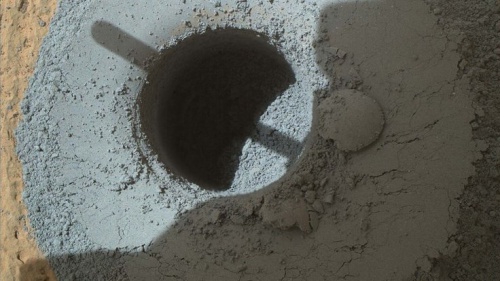Underneath the surface of Mars is blue-gray
The new image from the Curiosity probe shows that the lower part of the Martian surface is blue-gray instead of red.
Discover phenomena that have no answer on Mars

Mars is considered to be a red planet because there is iron oxide on the surface, but the new material collected below shows blue-gray.(Photo: NASA)
According to the "digging" result below the surface of Mars, the Curiosity detector detected colors in a combination of blue and gray. IBTimes said on March 3 that Curiosity searched at the third drill site at the top of the Telegraph, near Mount Sharp. The device here for half a year and collecting specimens helps scientists identify colors.
Like Earth, Mars is primarily formed from silicon, oxygen and contains a large amount of iron, magnesium, aluminum, calcium, and potassium. However, scientists from the US Aeronautics Agency (NASA) were surprised to discover silicon at the peak area called the Telegraph.
"When graphing the silicon to magnesium ratio and the silicon to aluminum ratio, we found that the Telegraph peak area has a ratio close to the limit we once knew," said Doug Ming, a project investigator. NASA's Curiosity project, says.
Mars is considered a red planet because there is iron oxide on the surface. The process of contacting with oxygen and creating rust and the cause of the planet's surface is red.
- NASA ships find gray stones on the surface of Mars
- What is the small green spot on Mars's surface?
- Blue sunset on Mars surface
- 'White Christmas' on the surface of the red planet
- Mystery of life beneath the surface of Mars
- The surface of Mars is still inactive
- New discovery of life survival under the surface of Mars
- Mars may contain a giant ice lake
- Discovering a 130-meter-thick ice shelf hidden under the surface of Mars
- Mars contains more groundwater than Earth?
- Detecting a 20km lake under the surface of Mars
- Blue moon and Mars together illuminate tomorrow night sky
 Van Allen's belt and evidence that the Apollo 11 mission to the Moon was myth
Van Allen's belt and evidence that the Apollo 11 mission to the Moon was myth The levels of civilization in the universe (Kardashev scale)
The levels of civilization in the universe (Kardashev scale) Today Mars, the sun and the Earth are aligned
Today Mars, the sun and the Earth are aligned The Amazon owner announced a secret plan to build a space base for thousands of people
The Amazon owner announced a secret plan to build a space base for thousands of people